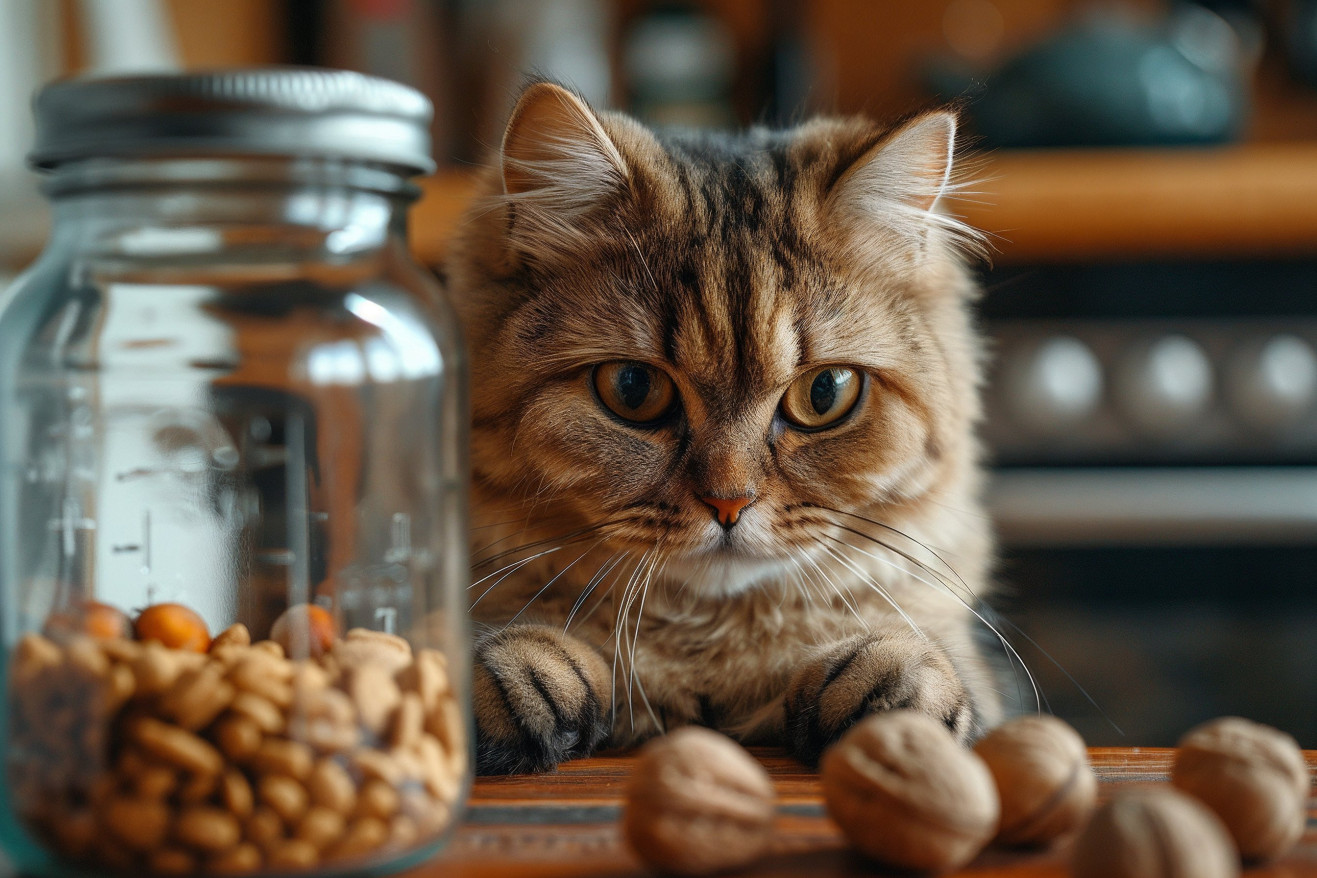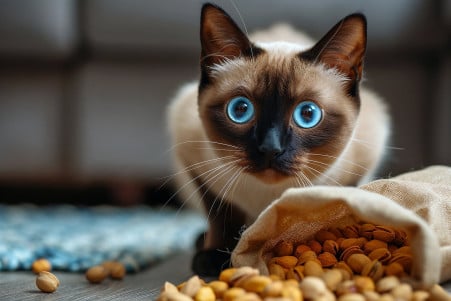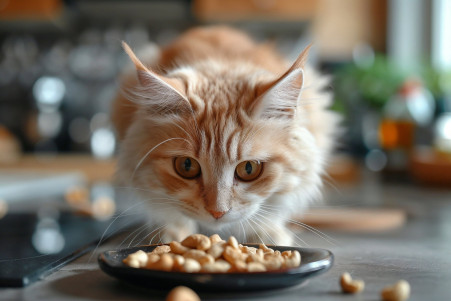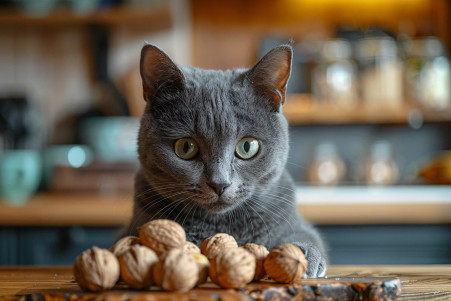Can Cats Have Nuts? Nutritional Information and Feline Health
5 February 2024 • Updated 5 February 2024

While nuts are a popular human snack, can cats partake in these tasty treats as well? Although most nuts are not poisonous to cats, veterinarians don’t recommend them. This is because cats are obligate carnivores and nuts don’t provide the nutrition they need.
Macadamia nuts are poisonous to cats and can lead to health problems. Feeding cats nuts is discouraged, but if you do decide to give them to your pet, it should be in moderation.
This article will explore a range of research studies and veterinary opinions to help shed light on the dietary needs and limitations of cats. By comparing the nutritional content of nuts to what cats need in their diet, we’ll learn why some nuts aren’t a good choice for cats. This deep dive into feline nutrition will give you the information you need to make the best choices for your cat’s diet and well-being.
Can cats eat nuts?
The Human Heart and Health: Nuts
Nuts are a nutritional goldmine for people. Packed with unsaturated fats, high-quality proteins, essential vitamins, and a variety of other bioactive compounds, nuts are well-known for their heart-healthy and weight-management benefits.
Studies published in PMC have shown that nuts are linked to a lower risk of coronary heart disease, and they lower cholesterol, among other heart-healthy effects. Nuts are also listed by the Cleveland Clinic as a source of dietary fiber, vitamins, and minerals that are important for a heart-healthy diet.
The Mayo Clinic also says that eating nuts as part of a healthy diet can lower inflammation that’s linked to heart disease and diabetes. Nuts are a source of monounsaturated and polyunsaturated fats, omega-3 fatty acids, and other nutrients that are good for the human heart. In fact, eating nuts regularly is associated with a lower risk of dying from heart disease, showing that they play a protective role in the human diet.
While the heart-healthy benefits of nuts for people are well-documented, the same can’t be said for cats. Cats have unique nutritional needs that don’t match up with the nutritional content of nuts. A look at the nutritional requirements of cats makes it clear that what’s good for people isn’t necessarily good for their feline friends.
The Carnivorous Cravings: A Cat’s Dietary Requirements
When it comes to what cats eat, one of the most important things to know is that cats are obligate carnivores. According to VCA Animal Hospitals, research has shown that cats are obligate carnivores, meaning they are obligate meat-eaters.
This means that cats are biologically dependent on meat for their survival. Cats have evolved to get certain nutrients that are vital to their health directly from animal tissue. These nutrients include taurine, arginine, and arachidonic acid, which are not present in plants and cannot be produced by cats in sufficient quantities.
For example, taurine is essential for heart health, vision, and reproduction. Without taurine, cats can develop heart disease, vision problems, and reproductive issues. Arginine is important for ammonia detoxification and insulin secretion, and arachidonic acid is important for skin health, kidney function, and reproduction.
Carbohydrates are not a significant part of a cat’s diet and are not the primary source of energy for cats as they are for omnivores and herbivores.
As obligate carnivores, cats need a diet that is high in protein, moderate in fat, and low in carbohydrates to be optimally healthy, which is the opposite of the nutritional content of plant-based foods.
According to Cornell University College of Veterinary Medicine, commercial cat foods are carefully formulated to meet strict nutritional standards through nutrient profiling, so every meal is nutritionally complete and balanced for cats. AAFCO guidelines are important for ensuring that commercial cat foods contain all the essential nutrients cats need, according to PetMD.
Knowing this, it’s easy to see why substituting or supplementing a cat’s diet with plant-based foods, which don’t contain the essential nutrients that come from animal-based foods, can throw off a cat’s nutritional balance.
Making Sense of the Nut Predicament in Cat Nutrition
Although nuts are not a part of a cat’s diet, there are a few that are classified as non-toxic and potentially safe if ingested in very small amounts.
According to Preventive Vet, some of the non-toxic options that are safe for cats in limited amounts include unsalted peanuts, hazelnuts, and shelled roasted cashews.
That said, the dangers of nuts, including the potential for weight gain, obesity, and pancreatitis, mean that they are not a good choice for your cat. The high fat content of nuts can lead to weight gain and other health problems, with obesity being a particular concern for indoor and neutered cats, according to research from Untamed.
Macadamia nuts are particularly toxic and can cause severe reactions in cats, including weakness, vomiting, and tremors.
If your cat eats macadamia nuts, it’s important to watch them carefully for signs of poisoning. If you suspect poisoning or if your cat shows any signs of toxicity, seek immediate veterinary attention.
The Animal Emergency & Referral Center of Minnesota recommends that you take your cat to the vet for an exam as soon as possible, ideally within 12 hours, if you notice any clinical signs of pancreatitis or toxicity, to ensure the cat’s safety and well-being.
The Feline Digestive Adaptation: A Carnivorous Conundrum
The feline digestive system is a wonder of evolutionary adaptation, perfectly suited to their carnivorous diet. A study in the Journal of Animal Science and Biotechnology explains that both the domestic cat (Felis catus) and its wild ancestors have anatomical and metabolic adaptations that are the result of their diet, which is high in animal protein.
Cats have shorter digestive tracts than omnivorous mammals, including humans, and they lack certain enzymes, such as salivary amylase, which helps break down carbohydrates.
As a result, cats’ digestive systems are less efficient at processing plant-based foods like nuts than animal proteins and fats. The need for a diet high in animal protein, particularly the amino acids taurine and arginine, which are essential to cats’ health and only found in animal tissues, is reflected in cats’ limited ability to synthesize and use these amino acids.
Moreover, a study in the Journal of Animal Science and Biotechnology explains that cats have a limited ability to synthesize these essential amino acids from precursors, which exacerbates the problem with nuts, which don’t contain these building blocks.
These adaptations help explain why nuts aren’t an ideal food for cats. Their metabolism, which has evolved to depend on animal tissues, can’t fully digest and absorb the nutrients in plant-based foods, which can lead to digestive and other health problems. This is an important consideration when evaluating whether a food like nuts is safe for cats to eat.
Feline Metabolism: Why Cats Can’t Eat Nuts Like People
Cats and humans have evolved to have very different metabolic systems, and this is especially true when it comes to how each species processes the food they eat.
Cats’ metabolic pathways have evolved to support their carnivorous diet, and they are set up to primarily break down and use animal-based protein and fat.
One study published in PMC found that cats have a unique pharmacokinetic profile compared to dogs and humans, which means that there are major differences in how drugs are metabolized in cats, and this is likely due to differences in the way that overall metabolism works in cats.
In addition, because of these metabolic differences, feeding cats foods like nuts that are staples in the human diet can lead to problems.
One study published in PubMed notes that obesity is a major problem in both humans and cats, but the metabolic response to overeating is very different in the two species. This shows that it’s important to feed cats a diet that works with their metabolic system, which is very different from that of humans.
Because of these significant metabolic differences, it’s clear that foods that are good for humans may not be good for cats and may even be toxic to them. Nuts, while they are a healthy food for humans, can be dangerous for cats and don’t meet their strict dietary requirements.
This knowledge should help pet owners make better nutritional choices that take into account their feline friends’ unique metabolic systems, and this will help ensure that they live long and healthy lives.
Making Sense of the Nutty Nuances: A Review of Feline Nutrition
So, in conclusion, while nuts have been shown to have a number of health benefits for humans, including improved heart health and weight control, they don’t meet the nutritional requirements of a cat’s carnivorous diet.
Our investigation has shown that cats need the nutrients that are only found in animal proteins—nutrients like taurine, arginine, and arachidonic acid, which are not present in nuts. Add to that the fact that macadamia nuts are toxic to cats and other nuts can lead to weight gain, obesity, and pancreatitis, and there are plenty of reasons to avoid feeding nuts to your cat.
It’s important to remember that the feline digestive system and metabolism are adapted to a high-protein, low-carbohydrate diet, and that cats have a limited ability to digest the high-fat content of nuts. These physiological differences highlight the importance of feeding cats a diet that’s as close to their natural diet as possible, which is best for their health and well-being.
As responsible pet parents, we use the information we have to make the best nutritional choices for our cats. Veterinary studies and nutritional research help us make sure we’re giving our pets the best care possible. So let’s respect our cats’ carnivorous nature by feeding them a diet that’s perfectly suited to their nutritional needs, which means keeping nuts out of their diet and in the snack jars where they belong for us.


